Degradation of Non-Photosynthetic Vegetation in a Semi-Arid Rangeland
Abstract
:1. Introduction
2. Materials and Methods
2.1. Study Area
2.2. Fractional Cover
2.3. Local Scaling of Components of Fractional Cover
2.3.1. Land Capability Classes
2.3.2. Scaling Approach
2.3.3. Validation of Scaling Results
3. Results
3.1. Comparison of Condition Metrics
3.1.1. Comparison of Observed and Scaled Components of Fractional Cover and Degradation
3.1.2. Comparison of Components of Fractional Cover along a Rainfall Gradient
3.1.3. Inter-Comparison of NPP and Fractional Cover
3.2. Scaled Components of Fractional Cover and Scaled NPP
3.2.1. Geographic Relationships between Scaled Components of Fractional Cover and Scaled NPP
3.2.2. Spatial Similarities of Scaled Components of Fractional Cover and Scaled NPP
3.2.3. Comparison of Degradation Maps
3.3. Relationship between Components of Fractional Cover and Degradation
Comparison of Inter-Annual Trends
3.4. Inter-Annual Trends in Scaled Components of Fractional Cover
Comparison with Vegetation Assets, State, and Transition (VAST)
4. Discussion
4.1. Relationship between Components of Fractional Cover and NPP
4.2. Degradation and Components of Fractional Cover in the BDT
4.3. Interpretation of Non-Photosynthetic Vegetation
5. Conclusions
Acknowledgments
Author Contributions
Conflicts of Interest
References
- Pickup, G. Estimating the effects of land degradation and rainfall variation on productivity in rangelands: An approach using remote sensing and models of grazing and herbage dynamics. J. Appl. Ecol. 1996, 33, 819–832. [Google Scholar] [CrossRef]
- Pickup, G.; Bastin, G.N.; Chewings, V.H. Identifying trends in land degradation in non-equilibrium rangelands. J. Appl. Ecol. 1998, 35, 365–377. [Google Scholar] [CrossRef]
- Safriel, U.; Adeel, Z. Dryland systems. In Millennium Ecosystem Assessment: Ecosystems and Human Well-Being: Current State and Trends; Hassan, R., Scholes, R., Ash, N., Eds.; Island Press: Washington, DC, USA, 2005; Volume 1, p. 638. [Google Scholar]
- Reynolds, J.F.; Smith, D.M.; Lambin, E.F.; Turner, B.L., II; Mortimore, M.; Batterbury, S.P.; Downing, T.E.; Dowlatabadi, H.; Fernandez, R.J.; Herrick, J.E.; et al. Global desertification: Building a science for dryland development. Science 2007, 316, 847–851. [Google Scholar] [CrossRef] [PubMed]
- Adeel, Z. Findings of the global desertification assessment by the Millennium Ecosystem Assessment—A perspective for better managing scientific knowledge. In Future of Drylands; Lee, C., Schaaf, T., Eds.; Springer: Dordrecht, The Netherlands, 2008; pp. 677–685. [Google Scholar]
- Reynolds, J.F.; Maestre, F.T.; Kemp, P.R.; Stafford-Smith, D.M.; Lambin, E. Natural and human dimensions of land degradation in drylands: Causes and consequences. In Terrestrial Ecosystems in a Changing World; Canadell, J.G., Pataki, D.E., Pitelka, L.F., Eds.; Springer: Heidelberg, Germany, 2007; pp. 247–257. [Google Scholar]
- Bastin, G.; Pickup, G.; Chewings, V.; Pearce, G. Land degradation assessment in central Australia using a grazing gradient method. Rangel. J. 1993, 15, 190–216. [Google Scholar] [CrossRef]
- Ludwig, J.A.; Tongway, D.J.; Freudenberger, D.O.; Noble, J.C.; Hodgkinson, K.C. Landscape Ecology, Function and Management: Principles from Australia’s Rangelands; CSIRO Publishing: Melbourne, Australia, 1997. [Google Scholar]
- UNCCD. United nations convention to combat desertification in countries experiencing serious drought and/or desertification, particularly in Africa. In Proceedings of the United Nations General Assembly, New York, NY, USA, 17 June 1994.
- Reynolds, J.F.; Stafford Smith, D.M. (Eds.) Do humans cause deserts? In Global Desertification: Do Humans Create Deserts? Dahlem University Press: Berlin, Germany, 2002.
- Geist, H.J.; Lambin, E.F. Dynamic causal patterns of desertification. Bioscience 2004, 54, 819–827. [Google Scholar] [CrossRef]
- Prince, S.D. Spatial and temporal scales of measurement of desertification. In Global Desertification: Do Humans Create Deserts? Reynolds, J.F., Stafford Smith, D.M., Eds.; Dahlem University Press: Berlin, Germany, 2002; pp. 23–40. [Google Scholar]
- Prince, S.D. Where does desertification occur? Mapping dryland degradation at regional to global scales. In The End of Desertification? Disrupting Environmental Change in Drylands; Behnke, R., Matimore, M., Eds.; Springer: Berlin, Germany, 2016. [Google Scholar]
- Nusser, S.M.; Goebel, J.J. The national resources inventory: A long-term multi-resource monitoring programme. Environ. Ecol. Stat. 1997, 4, 181–204. [Google Scholar] [CrossRef]
- Wessels, K.J.; Prince, S.D.; Malherbe, J.; Small, J.; Frost, P.E.; VanZyl, D. Can human-induced land degradation be distinguished from the effects of rainfall variability? A case study in South Africa. J. Arid Environ. 2007, 68, 271–297. [Google Scholar] [CrossRef]
- Myneni, R.B.; Nemani, R.R.; Running, S.W. Estimation of global leaf area index and absorbed par using radiative transfer models. IEEE Trans. Geosci. Remote Sens. 1997, 35, 1380–1393. [Google Scholar] [CrossRef]
- Coppin, P.; Jonckheere, I.; Nackaerts, K.; Muys, B.; Lambin, E. Digital change detection methods in ecosystem monitoring: A review. Int. J. Remote Sens. 2004, 25, 1565–1596. [Google Scholar] [CrossRef]
- Turner, D.P.; Ritts, W.D.; Cohen, W.B.; Gower, S.T.; Running, S.W.; Zhao, M.S.; Costa, M.H.; Kirschbaum, A.A.; Ham, J.M.; Saleska, S.R.; et al. Evaluation of MODIS NPP and GPP products across multiple biomes. Remote Sens. Environ. 2006, 102, 282–292. [Google Scholar] [CrossRef]
- Zhang, K.F.; Li, X.W.; Zhou, W.H.; Zhang, D.X.; Yu, Z.R. Land resource degradation in China: Analysis of status, trends and strategye. Int. J. Sustain. Dev. World Ecol. 2006, 13, 397–408. [Google Scholar] [CrossRef]
- Bai, Y.; Wu, J.; Xing, Q.; Pan, Q.; Huang, J.; Yang, D.; Han, X. Primary production and rain use efficiency across a precipitation gradient on the Mongolia Plateau. Ecology 2008, 89, 2140–2153. [Google Scholar] [CrossRef] [PubMed]
- Prince, S.D.; Becker-Reshef, I.; Rishmawi, K. Detection and mapping of long-term land degradation using local net production scaling: Application to Zimbabwe. Remote Sens. Environ. 2009, 113, 1046–1057. [Google Scholar] [CrossRef]
- Wessels, K.J.; Prince, S.D.; Reshef, I. Mapping land degradation by comparison of vegetation production to spatially derived estimates of potential production. J. Arid Environ. 2008, 72, 1940–1949. [Google Scholar] [CrossRef]
- Jackson, H.; Prince, S.D. Degradation of net primary productivity in a semi-arid rangeland. Biogeosciences 2016, in press. [Google Scholar] [CrossRef]
- Huete, A.; Didan, K.; Miura, T.; Rodriguez, E.P.; Gao, X.; Ferreira, L.G. Overview of the radiometric and biophysical performance of the modis vegetation indices. Remote Sens. Environ. 2002, 83, 195–213. [Google Scholar] [CrossRef]
- Nagler, P.L.; Inoue, Y.; Glenn, E.P.; Russ, A.L.; Daughtry, C.S.T. Cellulose Absorption Index (CAI) to quantify mixed soil-plant litter scenes. Remote Sens. Environ. 2003, 87, 310–325. [Google Scholar] [CrossRef]
- Asner, G.P.; Heidebrecht, K.B. Desertification alters regional ecosystem-climate interactions. Glob. Chang. Biol. 2005, 11, 182–194. [Google Scholar] [CrossRef]
- Ren, H.R.; Zhou, G.S.; Zhang, F.; Zhang, X.S. Evaluating Cellulose Absorption Index (CAI) for non-photosynthetic biomass estimation in the desert steppe of Inner Mongolia. Chin. Sci. Bull. 2012, 57, 1716–1722. [Google Scholar] [CrossRef]
- Cao, X.; Chen, J.; Matsushita, B.; Imura, H. Developing a modis-based index to discriminate dead fuel from photosynthetic vegetation and soil background in the asian steppe area. Int. J. Remote Sens. 2010, 31, 1589–1604. [Google Scholar] [CrossRef]
- Asner, G.P.; Wessman, C.A.; Bateson, C.A.; Privette, J.L. Impact of tissue, canopy, and landscape factors on the hyperspectral reflectance variability of arid ecosystems. Remote Sens. Environ. 2000, 74, 69–84. [Google Scholar] [CrossRef]
- Huete, A.R.; Miura, T.; Gao, X. Land cover conversion and degradation analyses through coupled soil-plant biophysical parameters derived from hyperspectral EO-1 Hyperion. IEEE Trans. Geosci. Remote Sens. 2003, 41, 1268–1276. [Google Scholar] [CrossRef]
- Guerschman, J.P.; Hill, M.J.; Renzullo, L.J.; Barrett, D.J.; Marks, A.S.; Botha, E.J. Estimating fractional cover of photosynthetic vegetation, non-photosynthetic vegetation and bare soil in the Australian tropical savanna region upscaling the eo-1 hyperion and modis sensors. Remote Sens. Environ. 2009, 113, 928–945. [Google Scholar] [CrossRef]
- Mellick, B.; Hanlon, H. The Burdekin Dry Tropics Natural Resources Management Plan (2005–2010); Burdekin Dry Tropics Board: Townsville, Australia, 2005. [Google Scholar]
- Petheram, C.; McMahon, T.A.; Peel, M.C. Flow characteristics of rivers in northern Australia: Implications for development. J. Hydrol. 2008, 357, 93–111. [Google Scholar] [CrossRef]
- Rustomji, P.; Bennett, N.; Chiew, F. Flood variability east of Australia’s great dividing range. J. Hydrol. 2009, 374, 196–208. [Google Scholar] [CrossRef]
- The State of Queensland: Reef Water Quality Protection Plan Secretariat: First Report Card 2009 Baseline. Brisbane, Australia, 2011.
- MODIS-Fractional Cover Product. Available online: http://www.auscover.org.au (accessed on 1 September 2015).
- Guerschman, J.P.; Oyarzabal, M.; Malthus, T.; McVicar, T.; Byrne, G.; Randall, L. Evaluation of the Modis-Based Vegetation Fractional Cover product; CSIRO: Canberra, Australia, 2012. [Google Scholar]
- MacQueen, J.B. Some methods for classification and analysis of multivariate observations. In Proceedings of the 5-th Berkeley Symposium on Mathematical Statistics and Probability, Berkeley, CA, USA, 21 June 1967.
- Weymouth, G.; Mills, G.A.; Jones, D.; Ebert, E.E.; Manton, M.J. A continental-scale daily rainfall analysis system. Aust. Meteorol. Mag. 1999, 48, 169–179. [Google Scholar]
- Jones, D.A.; Wang, W.; Fawcett, R. High-quality spatial climate data-sets for Australia. Aust. Meteorol. Oceanogr. J. 2009, 58, 233–248. [Google Scholar]
- Australian Collaborative Land Evaluation Project. National Soil Data. National Committee on Soil and Terrain: Canberra, Australia, 2011. [Google Scholar]
- Danaher, T.; Armston, J.; Collett, L. (Eds.) A regression model approach for mapping woody foliage projective cover using Landsat imagery in Queensland, Australia. In Proceedings of the 2004 IEEE International Geoscience and Remote Sensing Symposium, Anchorage, AK, USA, 24 September 2004; pp. 523–527.
- Karfs, R.A.; Abbott, B.N.; Scarth, P.F.; Wallace, J.F. Land condition monitoring information for reef catchments: A new era. Rangel. J. 2009, 31, 69–86. [Google Scholar] [CrossRef]
- Scarth, P.; Byrne, M.; Danaher, T.; Henry, B.; Hassett, R.; Carter, J.; Timmers, P. State of the paddock: Monitoring condition and trend in ground cover across Queensland. In Proceedings of the 13th Australasian Remote Sensing Conference, Canberra, Australia, 24 November 2006.
- Chilcott, C.R.; McCallum, B.S.; Quirk, M.F.; Paton, C.J. Grazing Land Management Education Package Workshop Notes—Burdekin; Meat and Livestock Australia Limited: Sydney, Australia, 2003. [Google Scholar]
- Cohen, J. A coefficient of agreement for nominal scales. Educ. Psychol. Meas. 1960, 20, 37–46. [Google Scholar] [CrossRef]
- Visser, H.; de Nijs, T. The Map Comparison Kit. Environ. Model. Softw. 2006, 21, 346–358. [Google Scholar] [CrossRef]
- Running, S.W. Estimating terrestrial primary productivity by combining remote sensing and ecosystem simulation. In Remote Sensing of Biosphere Functioning; Hobbs, R.J., Mooney, H.A., Eds.; Springer-Verlag: New York, NY, USA, 1990; pp. 65–86. [Google Scholar]
- Huang, C.-Y.; Asner, G.P.; Barger, N.N. Modeling regional variation in net primary production of Pinyon-Juniper ecosystems. Ecol. Model. 2012, 227, 82–92. [Google Scholar] [CrossRef]
- Bastin, G.; Scarth, P.; Chewings, V.; Sparrow, A.; Denham, R.; Schmidt, M.; O’Reagain, P.; Shepherd, R.; Abbott, B. Separating grazing and rainfall effects at regional scale using remote sensing imagery: A dynamic reference-cover method. Remote Sens. Environ. 2012, 121, 443–457. [Google Scholar] [CrossRef]
- McKeon, G.; Hall, W.; Henry, B.; Stone, G.; Watson, I. Pasture Degradation and Recovery in Australia’s Rangelands: Learning from History; Department of Natural Resources Mines and Energy Queensland: Brisbane, Australia, 2004. [Google Scholar]
- Dregne, H.E. Desertification of arid lands. In Physics of Desertification; El-Baz, F., Hassan, M.H.A., Eds.; Martinus Nijhoff Publishers: Dordrecht, Netherlands, 1983; p. 242. [Google Scholar]
- Bastin, G.N.; Pickup, G.; Pearce, G. Utility of avhrr data for land degradation assessment—A case-study. Int. J. Remote Sens. 1995, 16, 651–672. [Google Scholar] [CrossRef]
- Dregne, H. Land degradation in the drylands. Arid Land Res. Manag. 2002, 16, 99–132. [Google Scholar] [CrossRef]
- Bai, Z.G.; Dent, D.L.; Olsson, L.; Schaepman, M.E. Proxy global assessment of land degradation. Soil Use Manag. 2008, 24, 223–234. [Google Scholar] [CrossRef]
- McAlpine, C.A.; Etter, A.; Fearnside, P.M.; Seabrook, L.; Laurance, W.F. Increasing world consumption of beef as a driver of regional and global change: A call for policy action based on evidence from Queensland (Australia), Colombia and Brazil. Glob. Environ. Chang. Hum. Policy Dimens. 2009, 19, 21–33. [Google Scholar] [CrossRef]
- Barson, M.; Randall, L.; Bordas, V. Land Cover Change in Australia. Results of the Collaborative Bureau of Rural Sciences—State Agencies' Project on Remote Sensing of Land Cover Change; Bureau of Rural Sciences: Kingston, ACT, Australia, 2000. [Google Scholar]
- Lepers, E.; Lambin, E.F.; Janetos, A.C.; DeFries, R.; Achard, F.; Ramankutty, N.; Scholes, R.J. A synthesis of information on rapid land-cover change for the period 1981–2000. Bioscience 2005, 55, 115–124. [Google Scholar] [CrossRef]
- Fensham, R.J. Land clearance and conservation of inland dry rainforest in north Queensland, Australia. Biol. Conserv. 1996, 75, 289–298. [Google Scholar] [CrossRef]
- Catterall, C.P.; Kingston, M. Human populations, bushland distribution in south east Queensland and the implications for birds. In Birds and Their Habitats: Status and Conservation in Queensland; Catterall, C.P., Driscoll, P.V., Hulsman, K., Muir, D., Taplin, A., Eds.; Queensland Ornithological Society Inc.: Townsville, Australia, 1993. [Google Scholar]
- Sinclear, L.K.; Jermyn, D.; Preston, R.A. Status and Change of Remnant Vegetation in South-East Queensland 1974–1989; Queensland Department of Housing, Local Government and Planning, Queensland Department of Primary Industries, Forest Service: Brisbane, Australia, 1993. [Google Scholar]
- Myers, N. Threatened biotas: “Hot spots” in tropical forests. Environmentalist 1988, 8, 187–208. [Google Scholar] [CrossRef] [PubMed]
- Woinarski, J.C.Z. Biodiversity conservation in tropical forest landscapes of Oceania. Biol. Conserv. 2010, 143, 2385–2394. [Google Scholar] [CrossRef]
- Rasiah, V.; Florentine, S.K.; Williams, B.L.; Westbrooke, M.E. The impact of deforestation and pasture abandonment on soil properties in the wet tropics of Australia. Geoderma 2004, 120, 35–45. [Google Scholar] [CrossRef]
- Prince, S.D. Mapping desertification in southern Africa. In Land Change Science: Observing, Monitoring, and Understanding Trajectories of Change on the Earth's Surface; Gutman, G., Janetos, A., Justice, C.O., Eds.; Kluwer: Dordrecht, The Netherlands, 2004; pp. 163–184. [Google Scholar]
- Brown, J.R.; Scanlan, J.C.; McIvor, J.G. Competition by herbs as a limiting factor in shrub invasion in grassland: A test with different growth forms. J. Veg. Sci. 1998, 9, 829–836. [Google Scholar] [CrossRef]
- Jones, R.J. Steer gains, pasture yield and pasture composition on native pasture and on native pasture oversewn with Indian Couch (Bothriochloa pertusa) at three stocking rates. Aust. J. Exp. Agric. 1997, 37, 755–765. [Google Scholar] [CrossRef]
- Silcock, R.G.; Hall, T.J.; Filet, P.G.; Kelly, A.M.; Osten, D.; Schefe, C.M.; Knights, P.T. Floristic composition and pasture condition of aristida/bothriochloa pastures in central Queensland. I. Pasture floristics. Rangel. J. 2015, 37, 199–215. [Google Scholar]
- Kutt, A.S.; Fisher, A. Increased grazing and dominance of an exotic pasture (Bothriochloa pertusa) affects vertebrate fauna species composition, abundance and habitat in savanna woodland. Rangel. J. 2011, 33, 49–58. [Google Scholar] [CrossRef]
- Ludwig, J.A.; Bastin, G.N.; Eager, R.W.; Karfs, R.; Ketner, P.; Pearce, G. Monitoring Australian rangeland sites using landscape function indicators and ground- and remote-based techniques. Environ. Monit. Assess. 2000, 64, 167–178. [Google Scholar] [CrossRef]
- Ludwig, J.A.; Bastin, G.N.; Wallace, J.F.; McVicar, T.R. Assessing landscape health by scaling with remote sensing: When is it not enough? Landsc. Ecol. 2007, 22, 163–169. [Google Scholar] [CrossRef]
- Stavi, I.; Lal, R. Achieving zero net land degradation: Challenges and opportunities. J. Arid Environ. 2015, 112, 44–51. [Google Scholar] [CrossRef]
- Lal, R.; Safriel, U.; Boer, B. Zero Net Land Degradation: A New Sustainable Development Goal for Rio+ 20; UNCCD: Bonn, Germany, 2012. [Google Scholar]
- Grainger, A. Is land degradation neutrality feasible in dry areas? J. Arid Environ. 2015, 112, 14–24. [Google Scholar] [CrossRef]
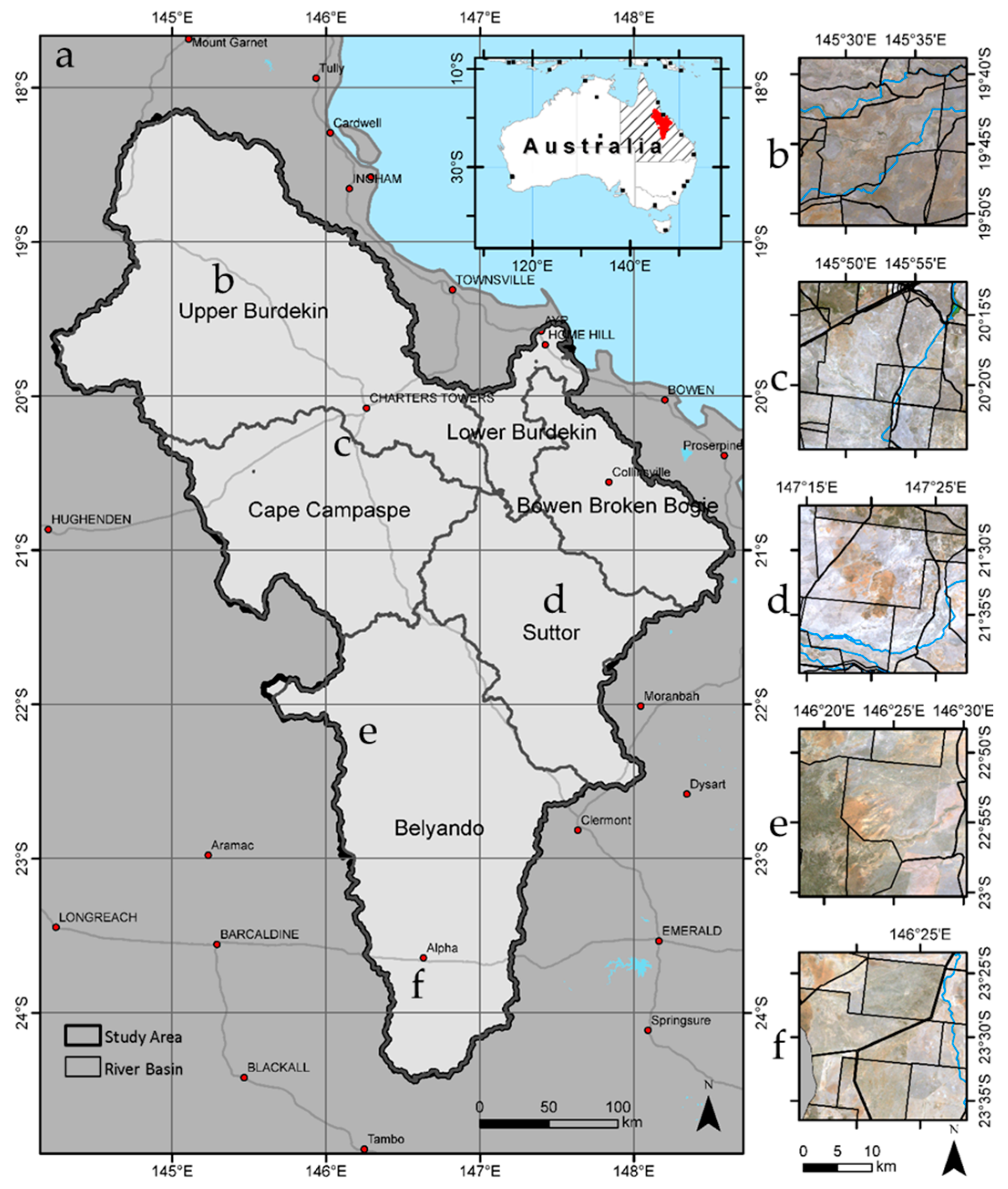
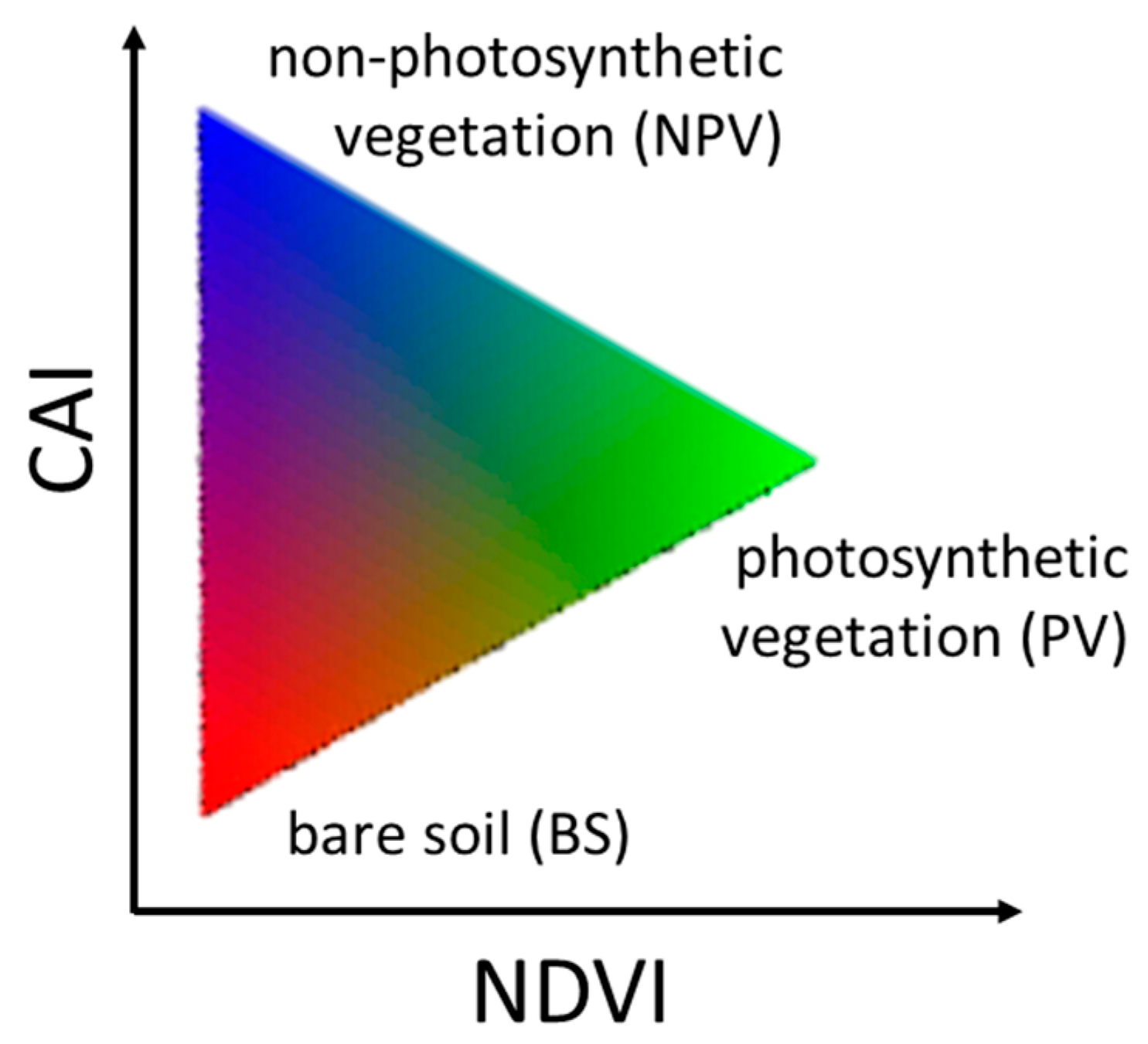
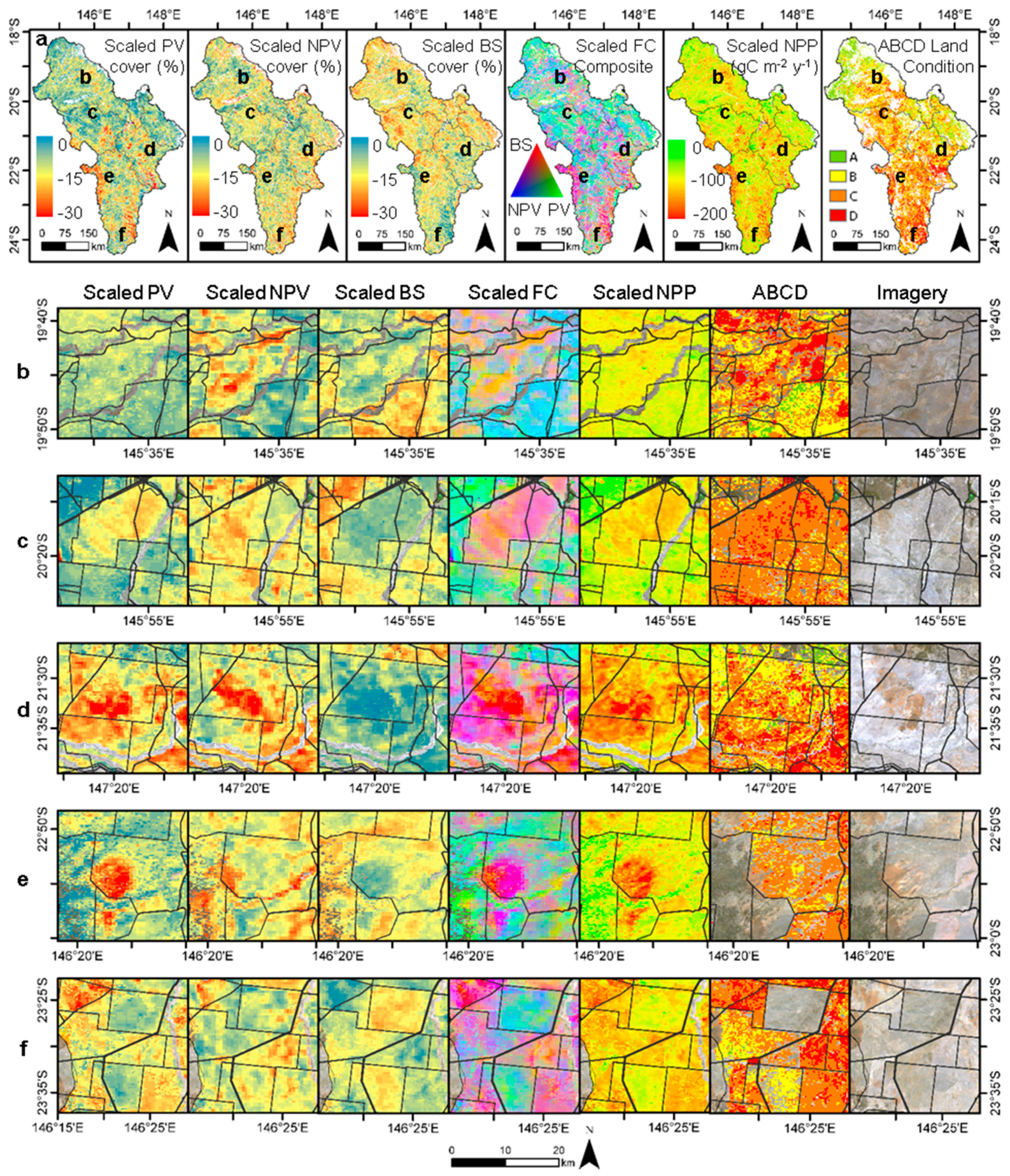
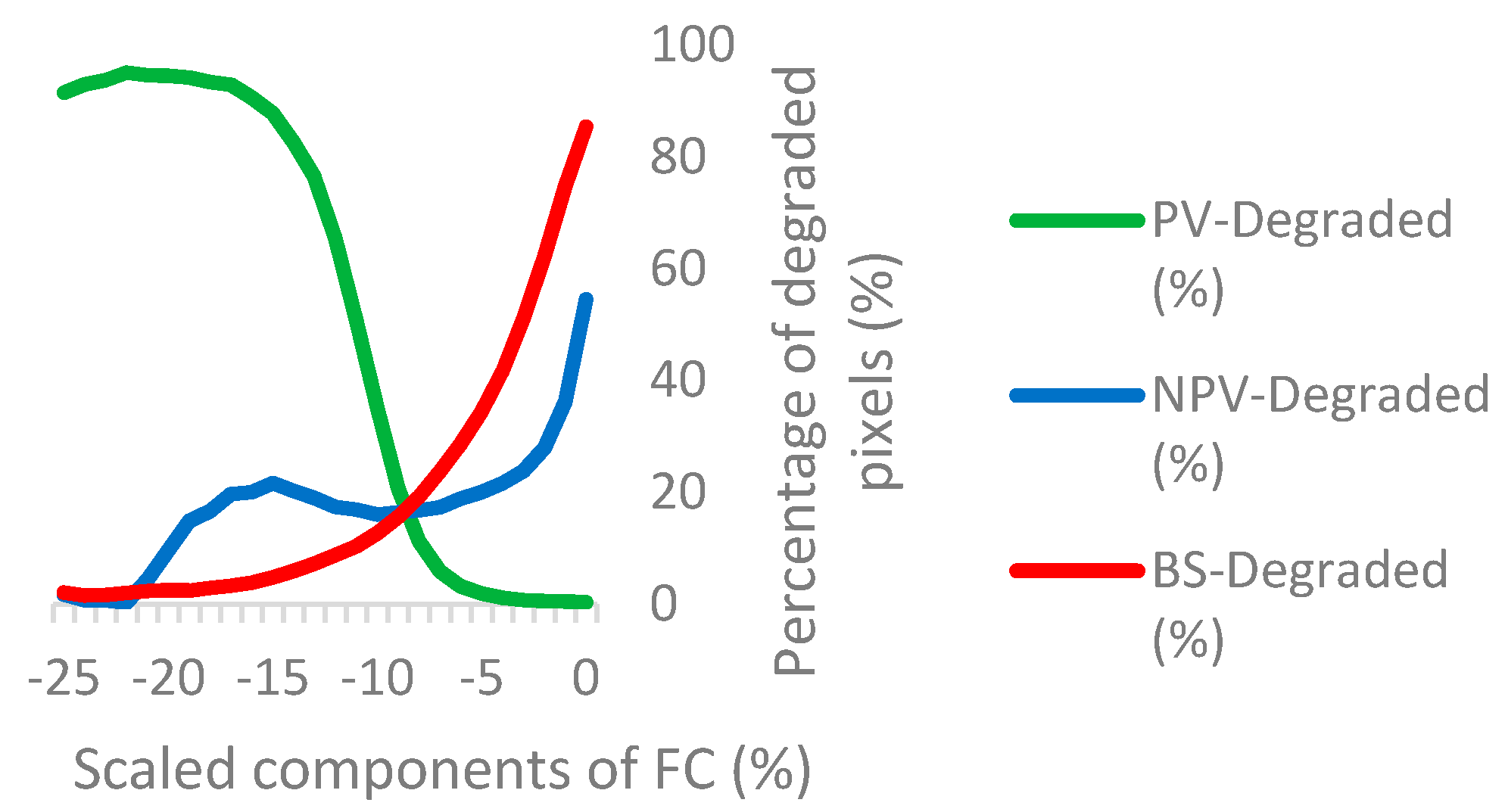
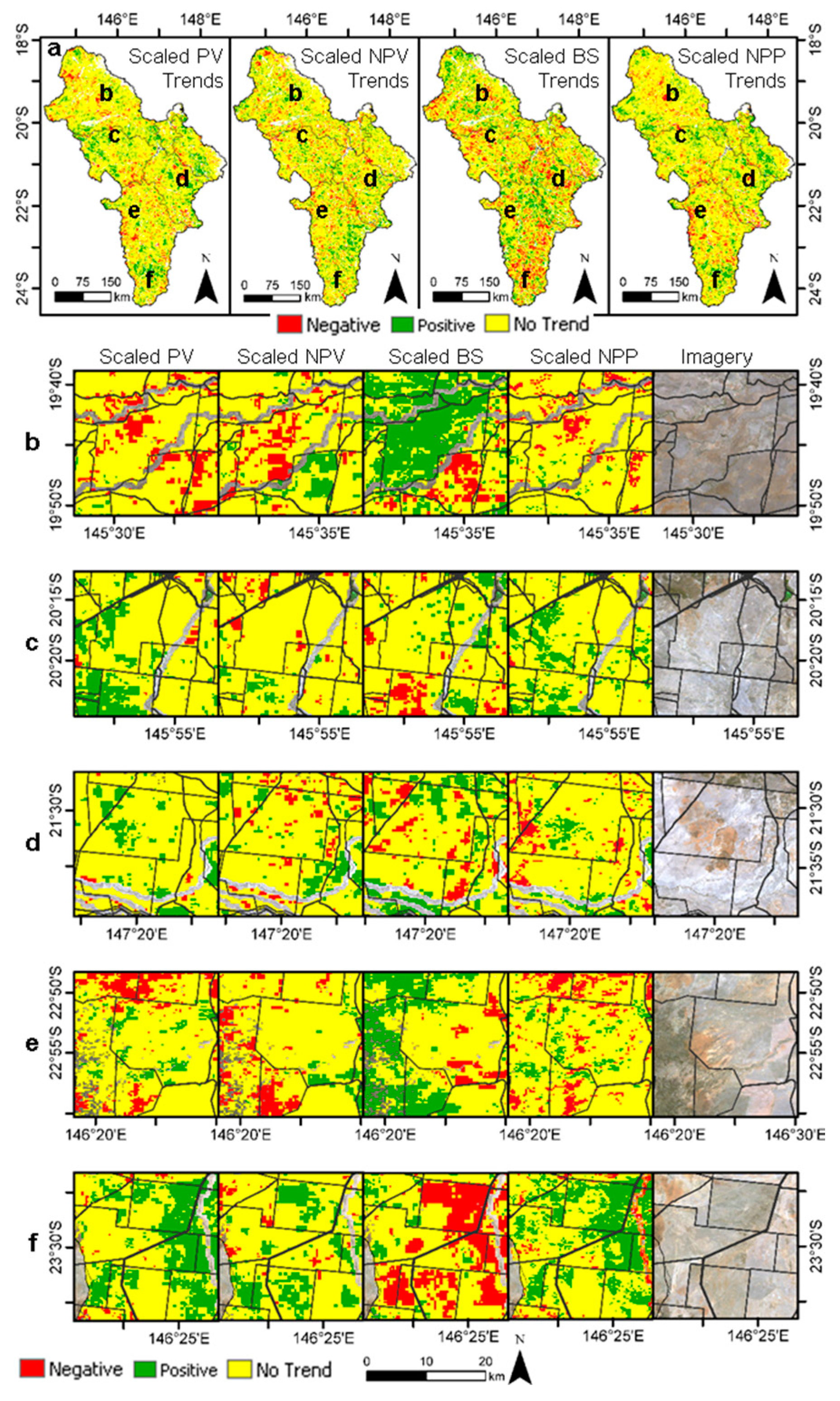
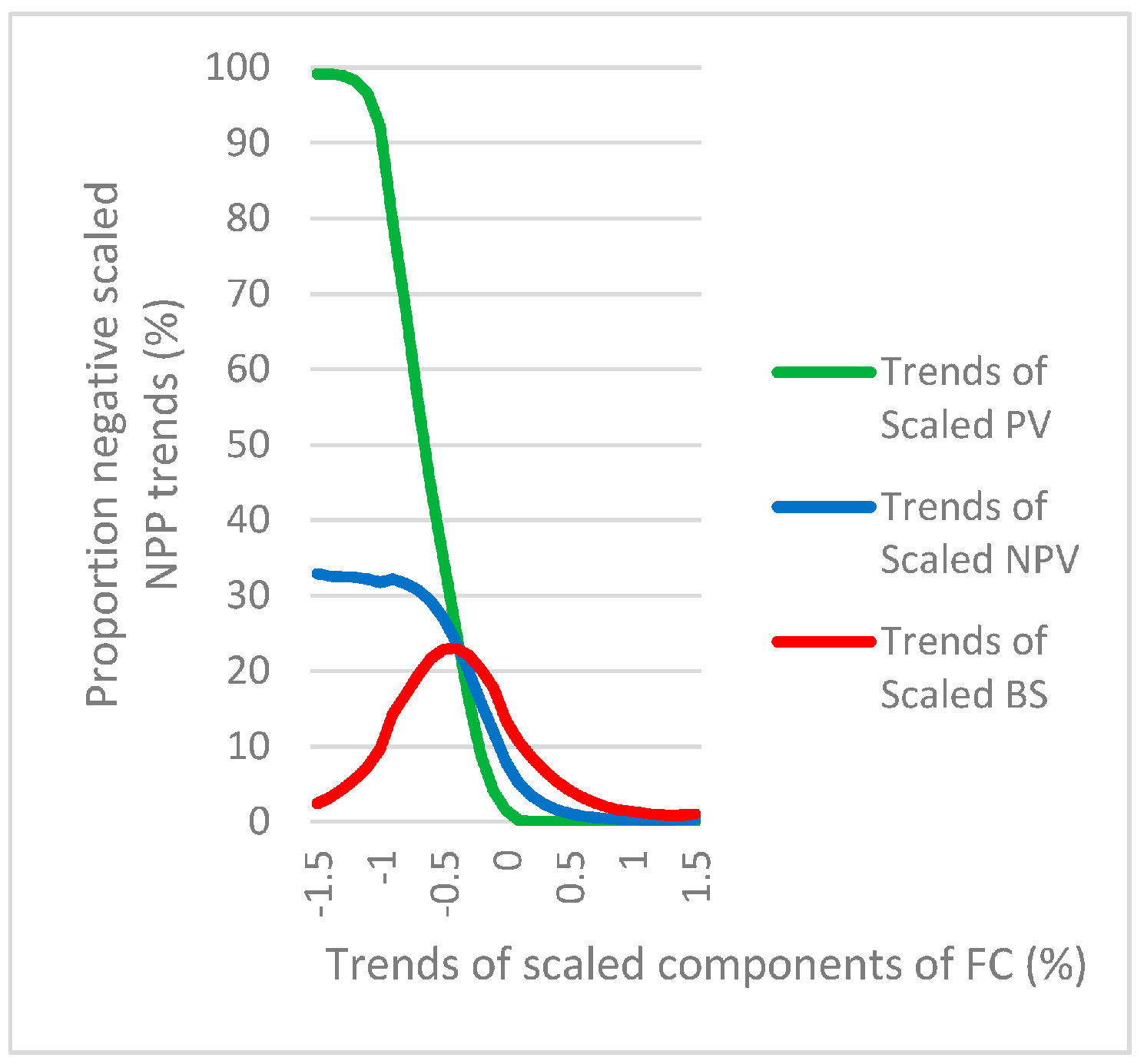
| Environmental Factor | Variable | Spatial Resolution | Duration | Source | Citation |
|---|---|---|---|---|---|
| Meteorological (daily) | Rainfall | 5 km | 2000–2013 | The Australian Bureau of Meteorology | Weymouth et al. [39] |
| Minimum Temperature | Jones et al. [40] | ||||
| Maximum Temperature | |||||
| Water vapor pressure deficit at 9 a.m. | |||||
| Water vapor pressure deficit at 3 p.m. | |||||
| Solar exposure | |||||
| Soil (static) | Plant available water holding capacity | 1 km | Static | ACLEP | ACLEP [41] |
| Soil bulk density | |||||
| Clay percentage | |||||
| Vegetation (1999) | Foliage projective cover | 30 m | Static | SLATS | Danaher et al. [42] |
| Observed Cover | Scaled Cover | |||||
|---|---|---|---|---|---|---|
| PV | NPV | BS | PV | NPV | BS | |
| Non-degraded | 38.5% (sd = 5.8) | 44.4% (sd = 3.7) | 17.6% (sd = 5.0) | −15.2% (sd = 7.2) | −13.8% (sd = 5.9) | −38.3% (sd = 12.0) |
| Degraded | 29.2% (sd = 5.3) | 46.1% (sd = 4.4) | 24.2% (sd = 6.3) | −32.1% (sd = 9.0) | −12.3% (sd = 6.5) | −23.4% (sd = 11.9) |
| Entire BDT | 36.5% (sd = 6.8) | 44.8% (sd = 3.9) | 19.0% (sd = 6.0) | −18.8% (sd = 10.3) | −13.5% (sd = 6.1) | −35.1% (sd = 13.4) |
| Annual Rainfall (mm) | Number of Pixels | Observed Cover | Scaled Cover | ||||
|---|---|---|---|---|---|---|---|
| PV | NPV | BS | PV | NPV | BS | ||
| 1700–2000 | 1715 | 53.0% (sd = 5.8) | 36.3% (sd = 3.4) | 13.5% (sd = 3.9) | −10.5% (sd = 7.3) | −23.2% (sd = 6.6) | −46.4% (sd = 11.3) |
| 1400–1699 | 6024 | 50.1% (sd = 5.9) | 39.5% (sd = 3.7) | 13.4% (sd = 4.2) | −12.4% (sd = 8.0) | −17.9% (sd = 6.6) | −47.6% (sd = 11.6) |
| 1100–1399 | 19,507 | 48.2% (sd = 5.0) | 40.7% (sd = 3.3) | 14.1% (sd = 4.1) | −12.5% (sd = 7.6) | −16.8% (sd = 5.8) | −45.5% (sd = 10.7) |
| 800–1099 | 111,549 | 44.4% (sd = 5.2) | 43.0% (sd = 3.8) | 15.1% (sd = 4.4) | −13.4% (sd = 7.8) | −14.0% (sd = 6.1) | −41.5% (sd = 12.1) |
| 500–799 | 1,558,842 | 35.7% (sd = 6.3) | 45.0% (sd = 3.8) | 19.3% (sd = 5.9) | −19.3% (sd = 10.3) | −13.4% (sd = 6.0) | −34.5% (sd = 13.3) |
| Regression with Scaled NPP | Observed Cover | Scaled Cover | ||||
|---|---|---|---|---|---|---|
| PV | NPV | BS | PV | NPV | BS | |
| Slope coefficient | 0.06 | −0.01 | −0.04 | 0.13 | −0.02 | −0.11 |
| SD of residuals | 5.8 | 3.8 | 5.5 | 6.2 | 5.9 | 11.5 |
| r | 0.53 | −0.22 | −0.40 | 0.80 | −0.21 | −0.51 |
| PV | NPV | BS | NPP | Scaled PV | Scaled NPV | Scaled BS | Scaled NPP | ABCD Condition | |
|---|---|---|---|---|---|---|---|---|---|
| PV | X | 0.59 | 0.52 | 0.92 | 0.46 | 0.63 | 0.49 | 0.54 | 0.58 |
| NPV | - | X | 0.62 | 0.59 | 0.67 | 0.45 | 0.57 | 0.68 | 0.67 |
| BS | - | - | X | 0.53 | 0.73 | 0.66 | 0.81 | 0.72 | 0.78 |
| NPP | - | - | - | X | 0.48 | 0.64 | 0.51 | 0.54 | 0.58 |
| Scaled PV | - | - | - | - | X | 0.58 | 0.79 | 0.75 | 0.68 |
| Scaled NPV | - | - | - | - | - | X | 0.71 | 0.55 | 0.63 |
| Scaled BS | - | - | - | - | - | - | X | 0.69 | 0.70 |
| Scaled NPP | - | - | - | - | - | - | - | X | 0.73 |
| ABCD condition | - | - | - | - | - | - | - | - | X |
| ABCD Condition Classes | Number of Pixels | Observed Cover | Scaled Cover | Scaled NPP (gC·m−2·year−1) | Percent Scaled NPP (%) | Percentage Degraded (%) | ||||
|---|---|---|---|---|---|---|---|---|---|---|
| PV | NPV | BS | PV | NPV | BS | |||||
| ‘A’—Good | 148,749 | 40.7 | 45.5 | 14.8 | −15.8 | −11.4 | −41.7 | −113.3 | −18.2 | 8.2 |
| ‘B’—Fair | 410,413 | 37.2 | 45.6 | 17.7 | −17.9 | −12.6 | −37.5 | −115.0 | −20.2 | 15.2 |
| ‘C’—Poor | 454,806 | 33.4 | 45.2 | 21.4 | −21.3 | −13.9 | −31.5 | −126.7 | −24.3 | 27.2 |
| ‘D’—Very Poor | 139,554 | 29.4 | 44.2 | 26.3 | −28.1 | −15.6 | −23.0 | −162.1 | −33.0 | 55.8 |
| Observed Cover | Scaled Cover | ||||||
|---|---|---|---|---|---|---|---|
| PV & NPV | PV & BS | NPV & BS | PV & NPV | PV & BS | NPV & BS | ||
| Non-degraded | Slope Coefficient | −0.7 | −0.8 | −0.2 | −0.4 | −0.4 | −0.2 |
| SD of residuals | 5.5 | 4.7 | 3.8 | 7.2 | 6.2 | 5.9 | |
| r | −0.5 | −0.6 | −0.2 | −0.3 | −0.6 | −0.4 | |
| Degraded | Slope Coefficient | −0.1 | −0.6 | −0.4 | −0.0 | −0.6 | −1.1 |
| SD of residuals | 5.2 | 3.6 | 3.6 | 6.5 | 10.4 | 9.4 | |
| r | −0.1 | −0.7 | −0.6 | −0.0 | −0.5 | −0.6 | |
| Trends of Scaled PV | Trends of Scaled NPV | Trends of Scaled BS | Trends of Scaled NPP | |
|---|---|---|---|---|
| Trends of scaled PV cover | X | 0.86 | 0.82 | 0.93 |
| Trends of scaled NPV cover | - | X | 0.82 | 0.85 |
| Trends of scaled BS cover | - | - | X | 0.82 |
| Trends of scaled NPP | - | - | - | X |
| VAST Classes | Scaled Slopes | ||
|---|---|---|---|
| PV | NPV | BS | |
| 0-‘residual’ | 0.03 (sd = 0.45) | 0.06 (sd = 0.38) | 0.66 (sd = 1.07) |
| 1-‘modified’ | 0.02 (sd = 0.30) | −0.04 (sd = 0.32) | 0.30 (sd = 0.81) |
| 2-‘transformed’ | 0.08 (sd = 0.27) | 0.04 (sd = 0.31) | 0.32 (sd = 0.84) |
| 3-‘replaced’ | 0.09 (sd = 0.30) | 0.04 (sd = 0.33) | 0.28 (sd = 0.75) |
| 4-‘removed’ | 0.10 (sd = 0.36) | 0.10 (sd = 0.38) | 0.23 (sd = 0.63) |
| 5-‘bare’ | 0.23 (sd = 0.55) | −0.11 (sd = 0.23) | 0.22 (sd = 0.38) |
© 2016 by the authors; licensee MDPI, Basel, Switzerland. This article is an open access article distributed under the terms and conditions of the Creative Commons Attribution (CC-BY) license (http://creativecommons.org/licenses/by/4.0/).
Share and Cite
Jackson, H.; Prince, S.D. Degradation of Non-Photosynthetic Vegetation in a Semi-Arid Rangeland. Remote Sens. 2016, 8, 692. https://doi.org/10.3390/rs8080692
Jackson H, Prince SD. Degradation of Non-Photosynthetic Vegetation in a Semi-Arid Rangeland. Remote Sensing. 2016; 8(8):692. https://doi.org/10.3390/rs8080692
Chicago/Turabian StyleJackson, Hasan, and Stephen D. Prince. 2016. "Degradation of Non-Photosynthetic Vegetation in a Semi-Arid Rangeland" Remote Sensing 8, no. 8: 692. https://doi.org/10.3390/rs8080692







